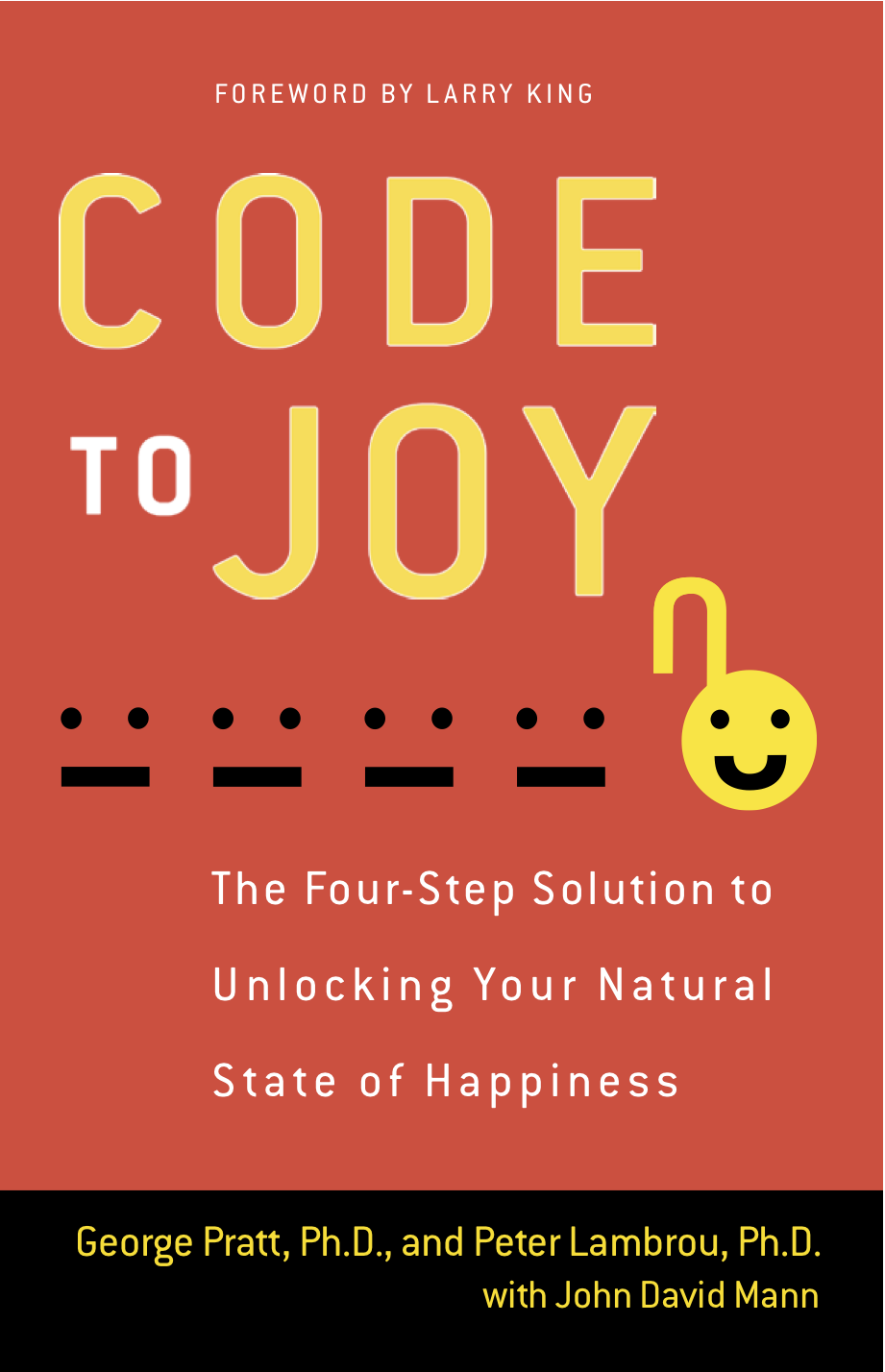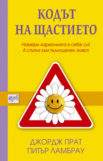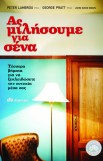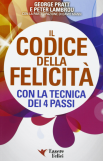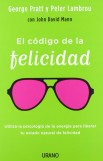Code to Joy
The Four-Step Solution to Unlocking Your Natural State of Happiness
We are meant to be happy.
Instinctively, we all know this, somewhere deep inside. We all know what it’s like to feel a burst of delight. Every one of us has at some point in our lives experienced a sense of ecstatic joy, of euphoria at the sheer sensation of being alive.
Have you ever wondered why that experience has to be so rare and fleeting?
The answer is, it doesn’t.
All the positive thinking, affirmations, talk therapy, and pharmaceuticals in the world will never be enough to make us as happy as we were designed to be, according to acclaimed clinical psychologists George Pratt, Ph.D., and Peter Lambrou, Ph.D. That’s because those approaches fail to address a third aspect of the human organism, one that bridges the gap between mind and body: the biofield.
Combining six decades of clinical experience with cutting-edge research, Drs. Pratt and Lambrou have developed a revolutionary program for rediscovering (and then never again letting go of) your innate happiness in four simple, proven steps.
Pratt and Lambrou’s program has already transformed the lives of more than 45,000 clients, including professional athletes, top executives, and celebrities. Code to Joy can transform yours, too, with all the science-based tools and guidance you need to complete the process of becoming a more focused, more powerful, and more deeply joyful you.
Foreign Language Editions
Now also available in Bulgarian, Chinese (modern). Greek, Italian, Portuguese, Romanian, and Spanish. (Clicking on the cover will take you to a site where you can order that edition.)
Code to Joy Reviews
“Code to Joy draws you in to a new way of thinking and being and eliminates that fog of distress that haunts so many. Dr. Pratt is a master clinician and skilled story-teller whose work will guide you to a happier, more joyful life. I highly recommend it.”
— Daniel G. Amen, M.D., Change Your Brain, Change Your Life
“One of the greatest discoveries of the twentieth century was the intimate connection between body, mind, and spirit. Drs. Pratt and Lambrou are on the cutting edge, turning that discovery into techniques that work.”
— Larry Dossey, M.D., Reinventing Medicine
“I love the powerful work George and Peter are doing. I’ve seen it touch people’s lives — even change people’s lives.”
— Common, Grammy Award-winning recording artist
“A simple, powerful, and brilliant method for experiencing authentic happiness from the inside out.”
— Marci Shimoff, Happy for No Reason
“When I was twenty-five years old I went to see Dr. Pratt and it changed my life. George’s work is the reason behind everything I have and everything I’ve accomplished, and you’ll learn these same tools in the pages of Code to Joy.”
— Rob Dyrdek, host of MTV’s Fantasy Factory
“George Pratt has had a huge impact on my ability to go further than I thought possible. There is no limit to what you can accomplish when you focus your abilities. Apply what you learn from reading Code to Joy and you’ll prove that to yourself!”
— Dara Torres, five-time Olympic champion
“George Pratt is one of the most gifted healers on the planet today. His work has touched my life and the lives of those throughout my global community.”
— Debbie Ford, The 21-Day Consciousness Cleanse
Excerpt from Code to Joy
You are walking through a field, munching absent-mindedly on a snack. The sun is out, the air is balmy. A light breeze at your back. Life is good.
Suddenly you hear an earthshaking crash.
Startled, you look up at the horizon just in time to see a gigantic plume of ash and dust volcanoing up into the sky and spreading out to form a gigantic cloud that will persist for days, weeks, perhaps years. It will blot out the sun and completely change your world. Chances are, you will not live to see it dissipate.
Oh, one more detail: You are a dinosaur.
Scientists tell us it was an asteroid striking Earth millions of years ago that caused the death of the dinosaurs. The impact threw so much debris into the atmosphere, they say, that it darkened the skies and transformed the climate into what is sometimes termed nuclear winter, so named because a similar effect would result from the explosion of a series of nuclear bombs.
The impact of traumatic personal events can have the same kind of effect, darkening the skies of our own outlook and causing a chilling effect that permeates every aspect of our lives.
Human beings are remarkably adaptable. Most of the time, when negative events occur, we are able to learn from them, shrug them off, and go on with our lives. The experience simply evaporates, leaving us a bit older and wiser. But not always. Sometimes, especially when we are very young, we have experiences that we cannot shake. Even if they seem insignificant, no more substantial than a glass of water, when these upsetting experiences evaporate, they then condense into billions of droplets of anger, fear, self-doubt, guilt, and other negative feelings, surrounding us with a suffocating blanket that suffuses every aspect of our lives for years to come.
We call this the fog of distress.
Typically, this vague sense of unease parks itself in the background, like the annoying hum of a refrigerator or air conditioner we have learned to block out from our conscious awareness. But whether we are aware of it or not, it pervades our existence like an insistent headache, interfering with our ability to have healthy relationships, to perform to our potential at work, or to have lives that are anywhere near as fulfilling as they could be. Over the years, that background hum can sabotage our careers, friendships, marriages. Sometimes, even our physical health starts to suffer.
What is this fog made of? It is part feelings and part beliefs, partly subconscious and partly bioelectrical. You can think of it as an interference pattern, like radio static, typically set up in the early years of childhood, when our defenses were still fairly unformed and we hadn’t yet developed our adult, logical ways of thinking. In other words, it lies outside the domain of our conscious, logical, verbal thought process. It is like a computer program running in the background, shading our thoughts and feelings, reactions and behaviors, our view of ourselves and of our world—all largely without our conscious awareness that it is even there.
For some, this fog of distress shows up in very distinct and specific ways, such as an unshakable fear or irrational anxiety, a problem in one particular area of life. For others, it is more vague and generalized. That is, it’s not that any one specific thing is so terribly wrong. It’s more that nothing is quite right.
Psychotherapeutic drugs, like antidepressants or anti-anxiety medications, cannot disperse that fog; at best, they can somewhat blunt its impact. Talking it over, whether with friends, counselors, or therapists, won’t disperse it either, because it doesn’t yield to reason and logical analysis. Trying to “talk it through” is like trying to reach an underwater cave by driving around the city streets. No matter how long you drive or which route you take, you won’t get there. We have to get out of the car, get off the streets and into the water, and swim a different route altogether.
Fortunately, such a path exists. That’s what this book is about.
